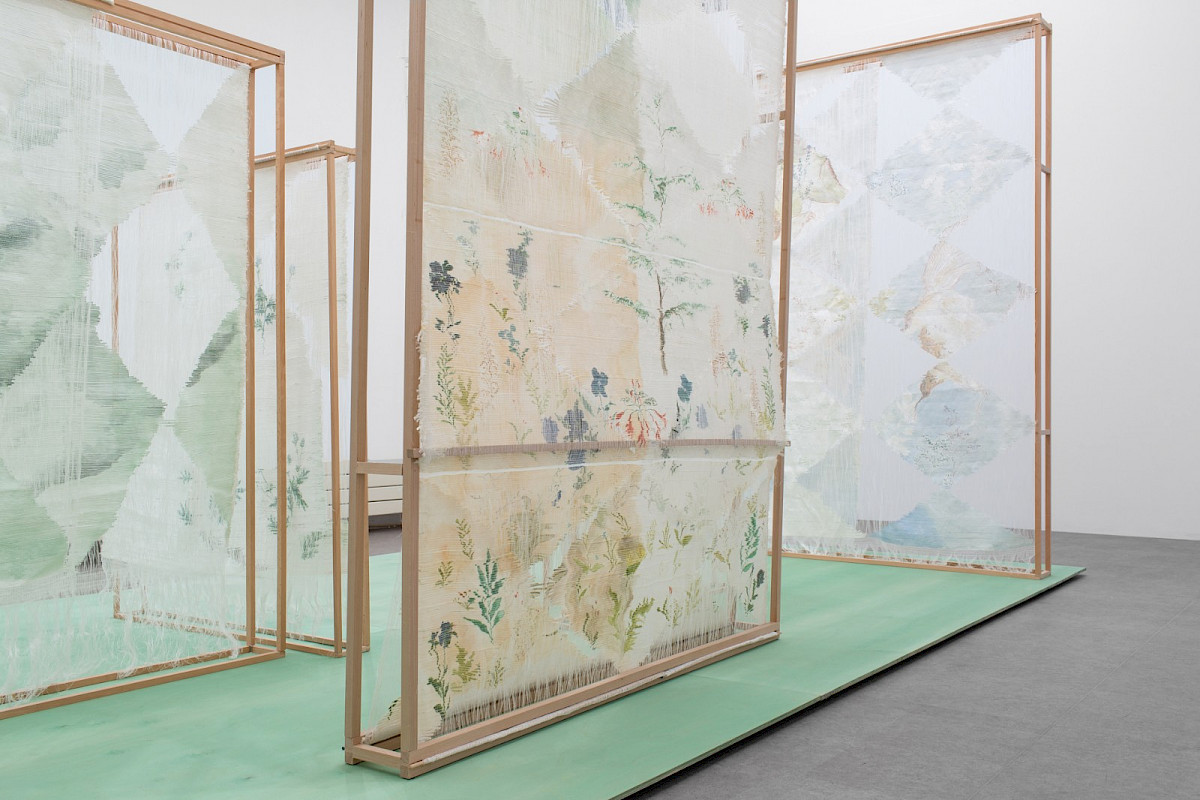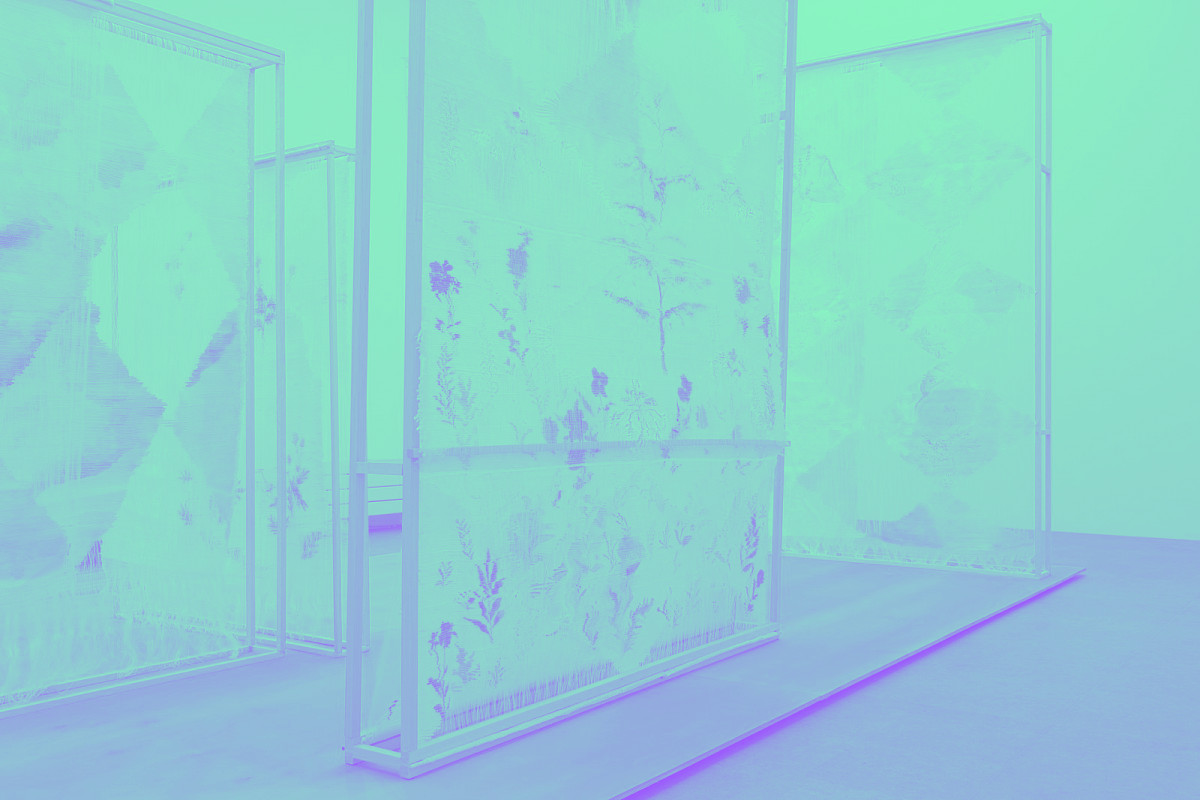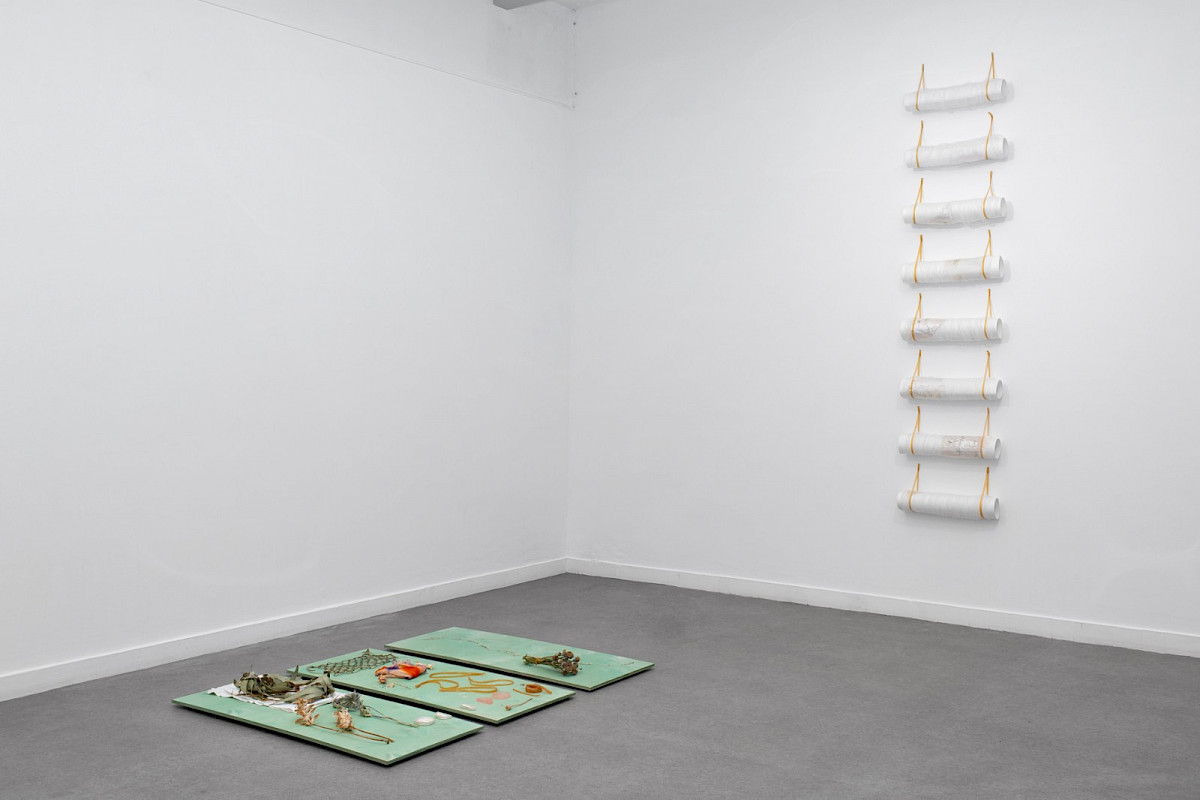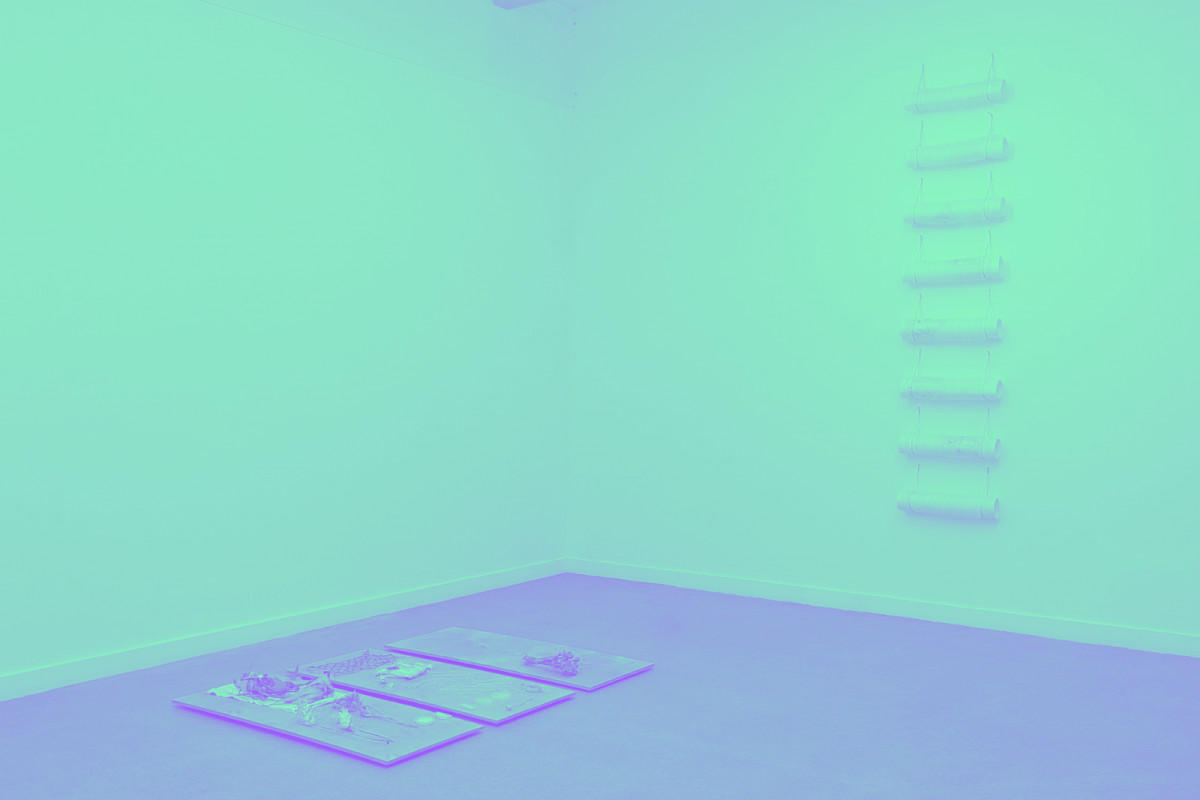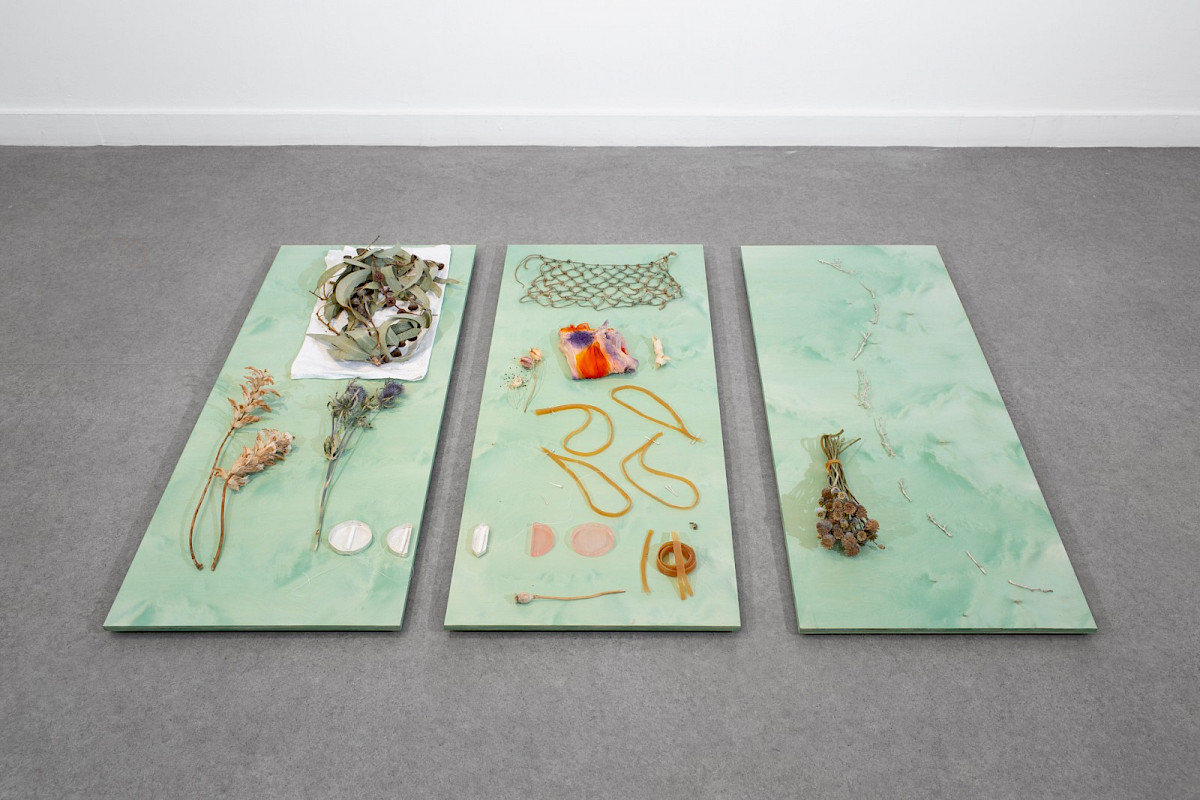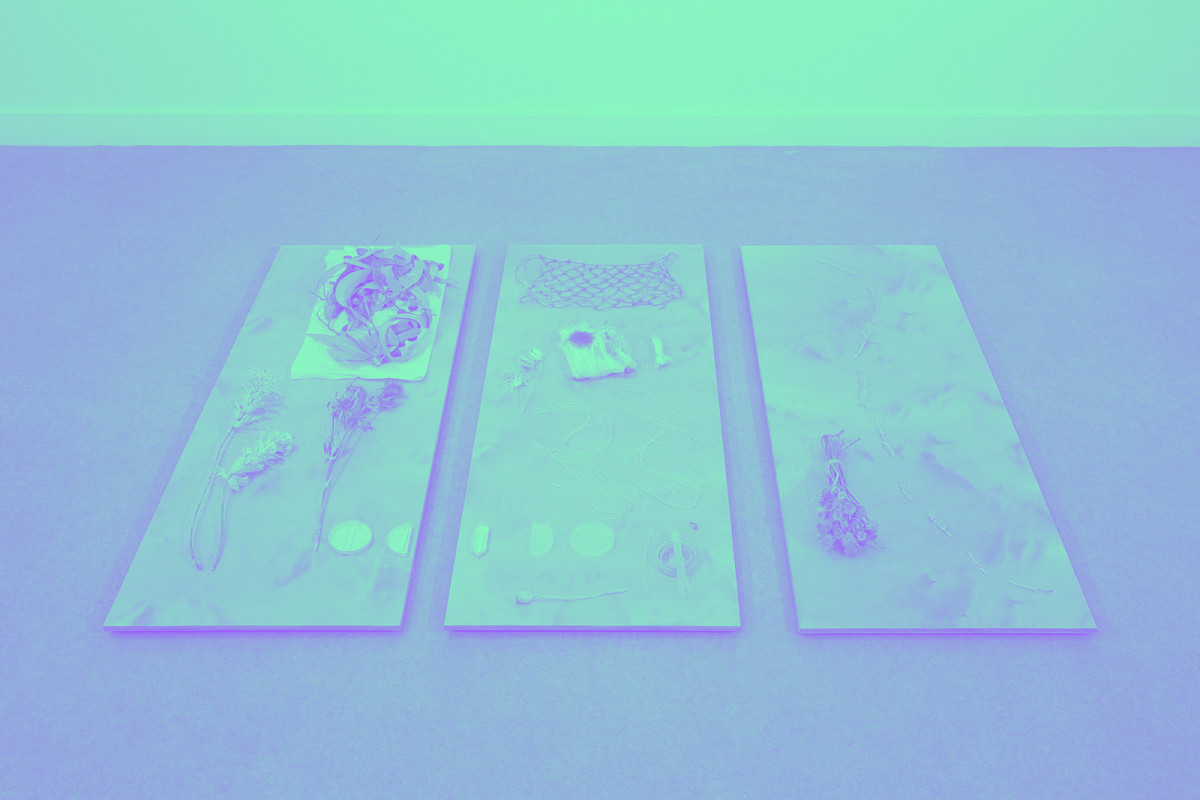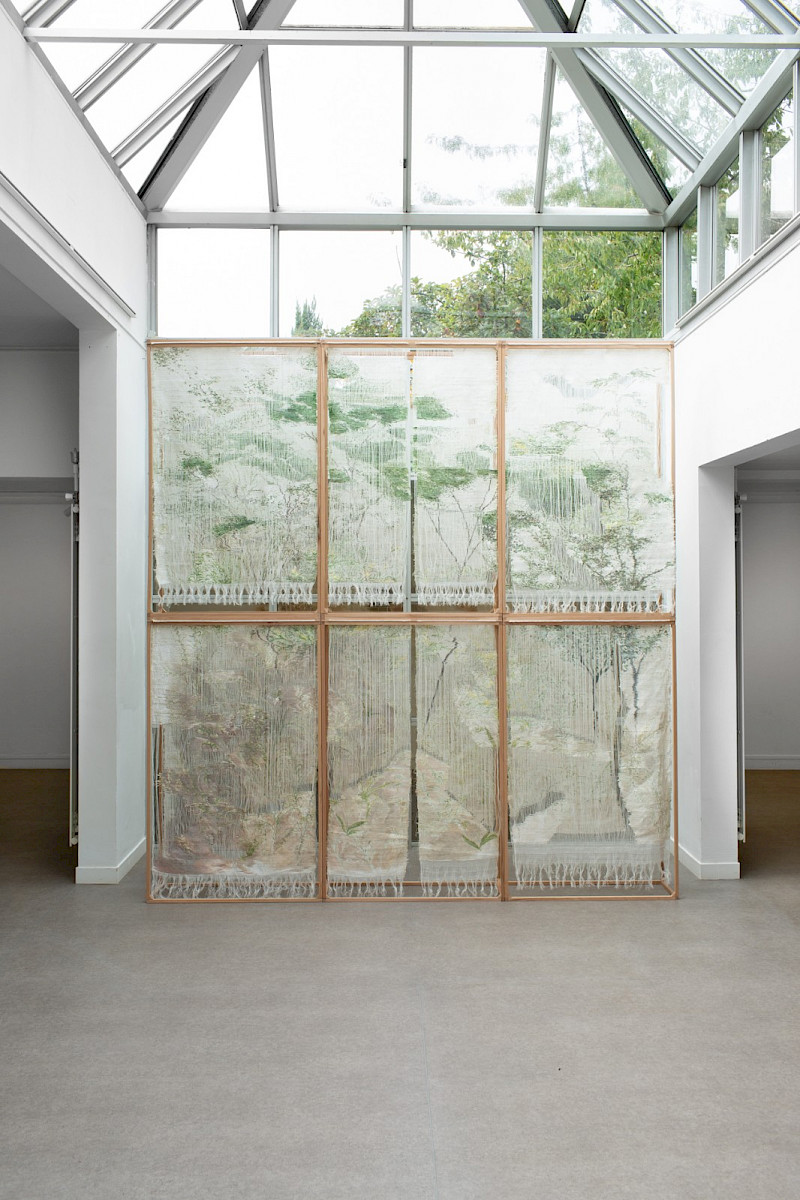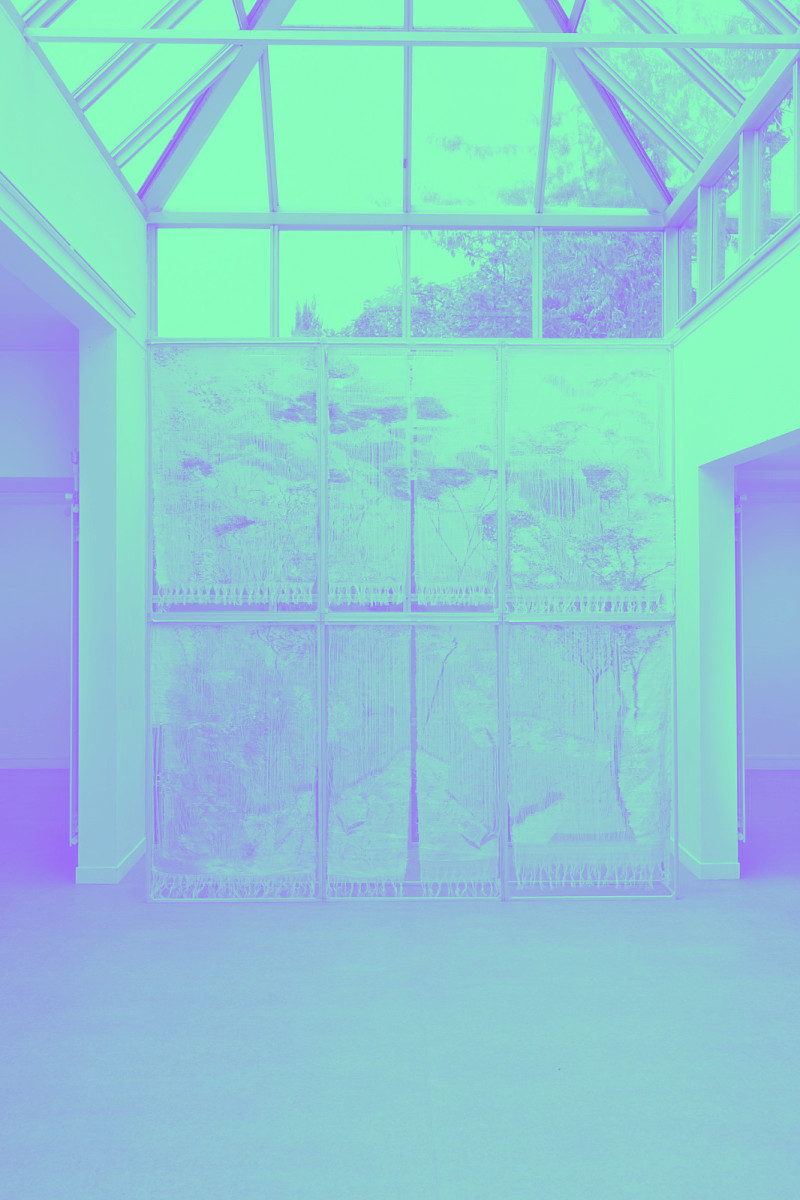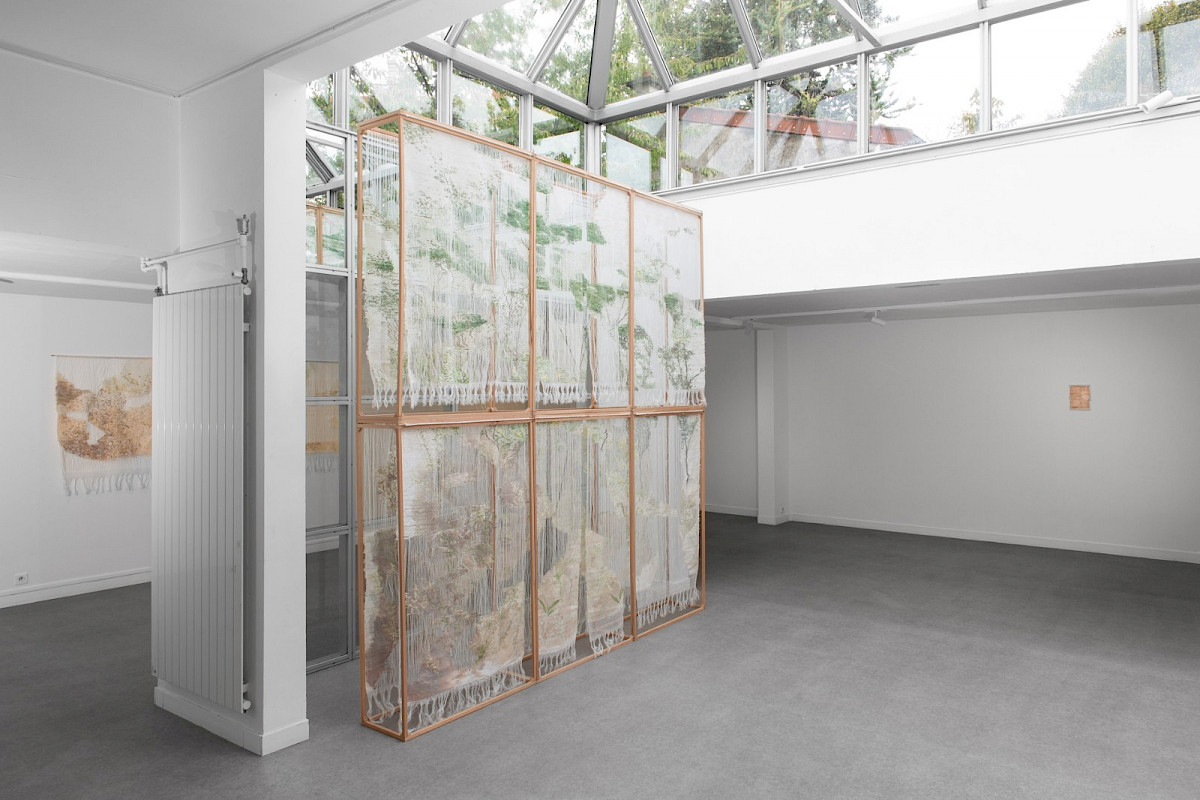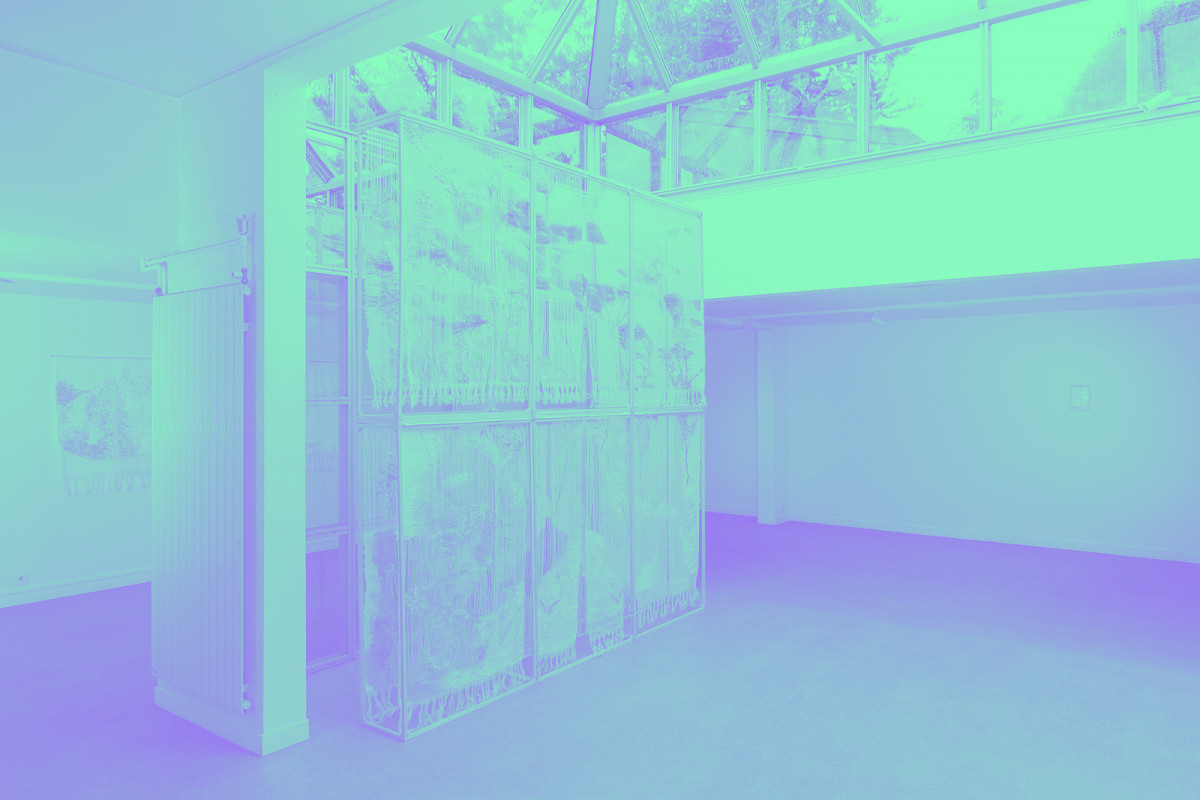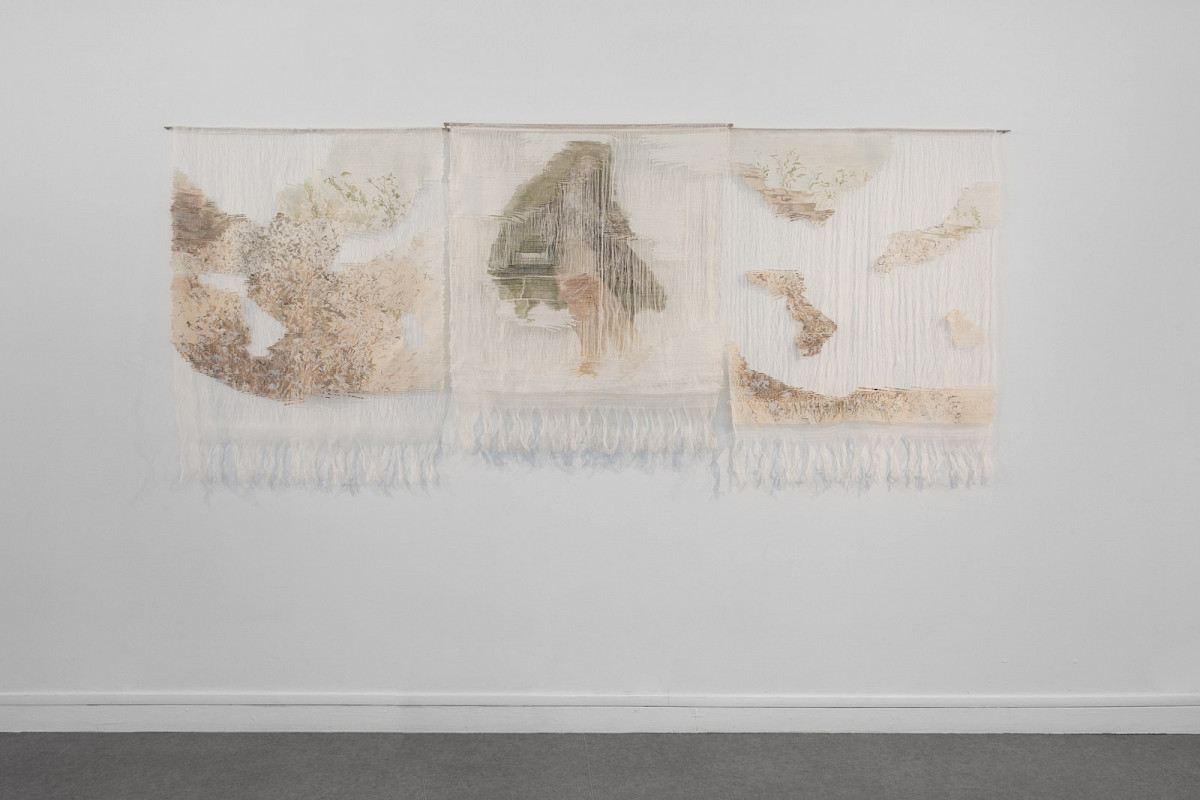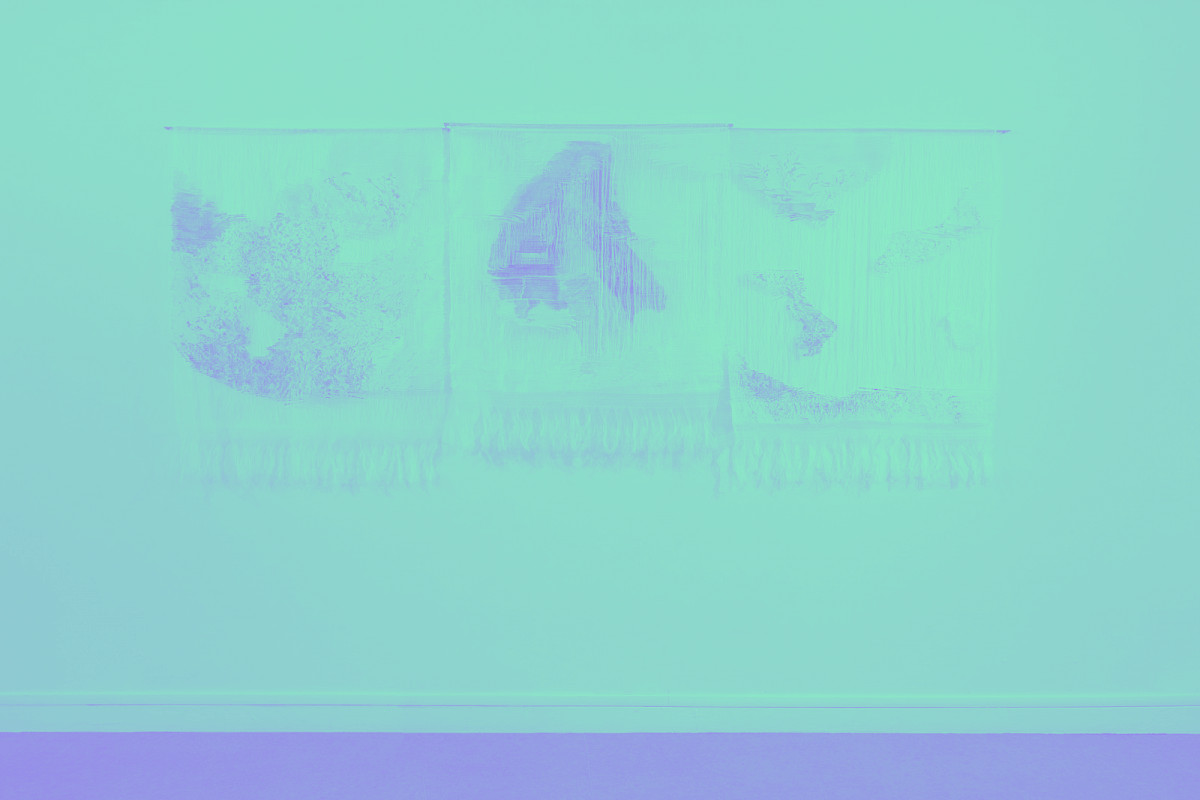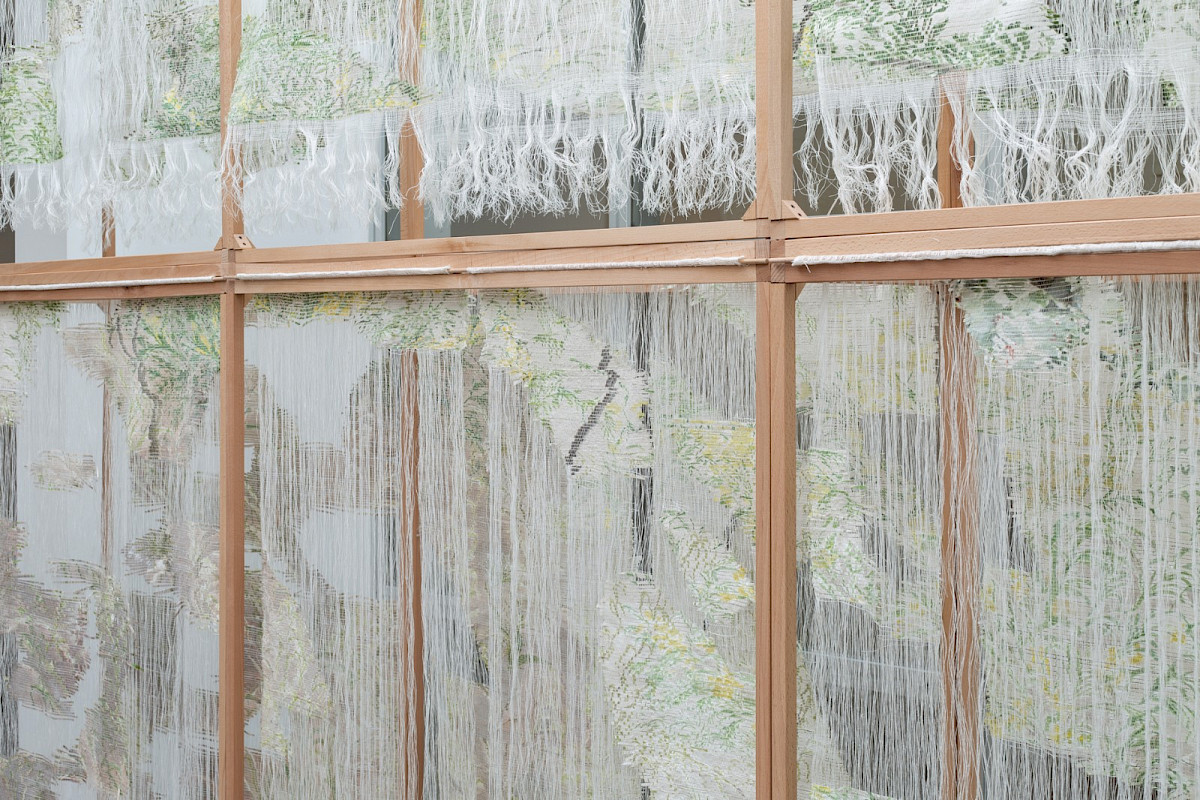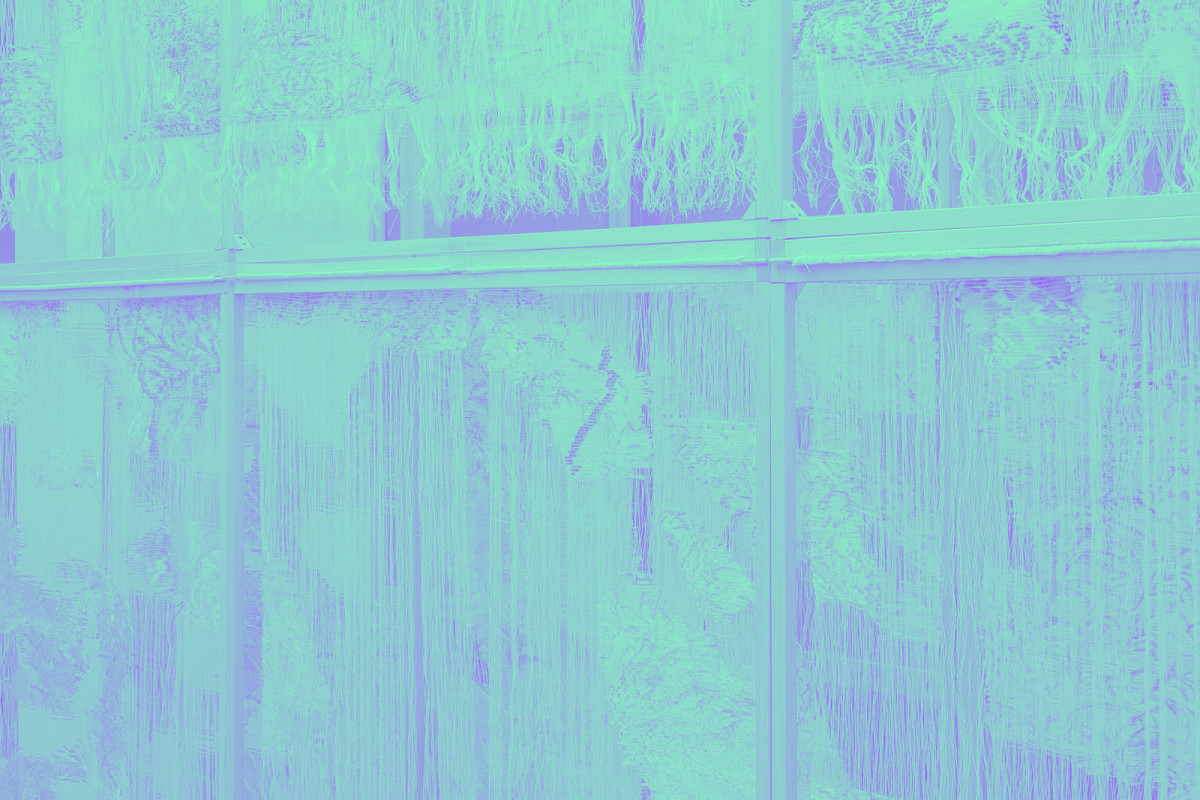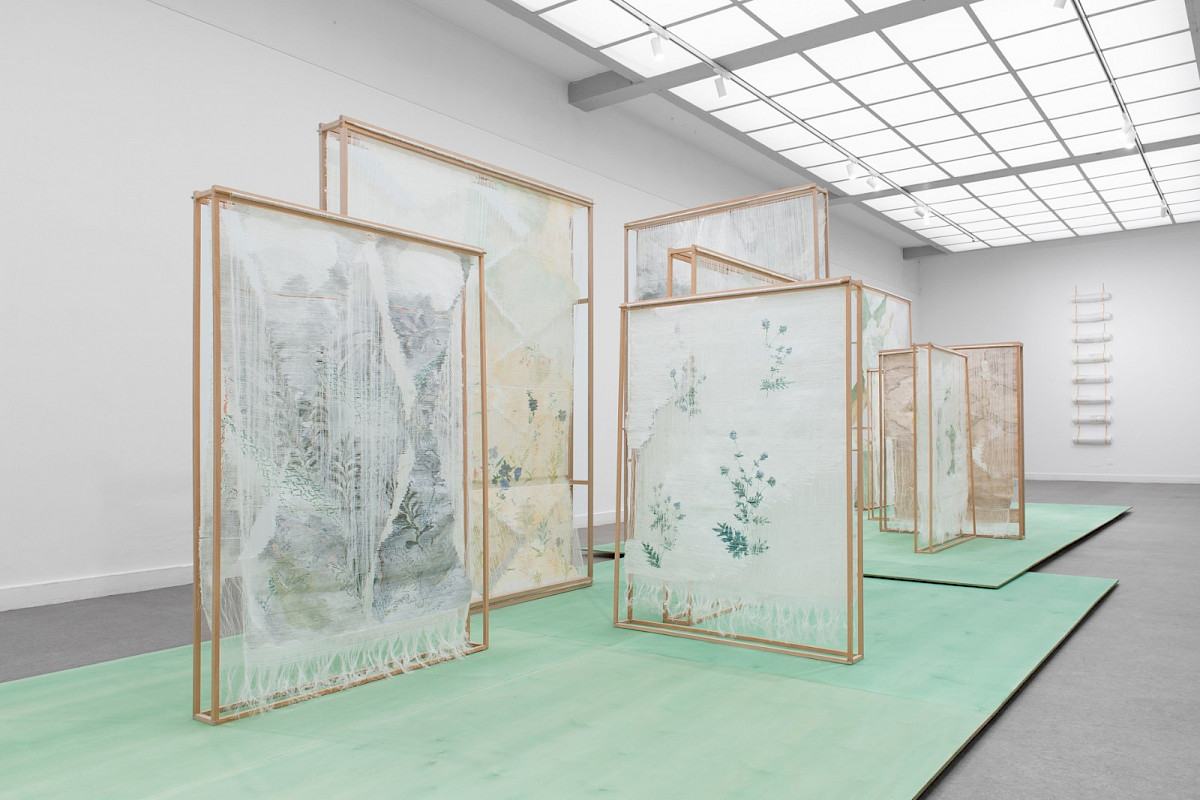
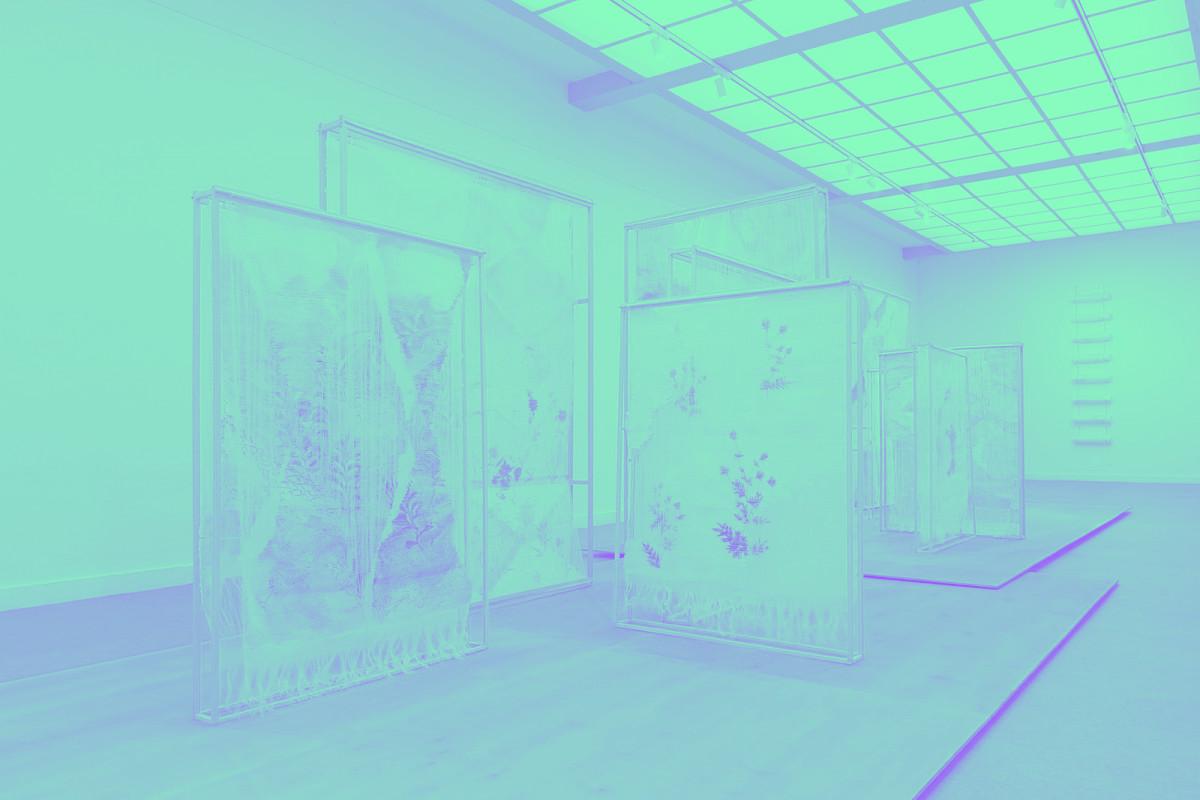
Élise Peroi’s installation structures are at once paintings, weavings, or perhaps even more like sculptures… A bit like nature on the move, a standing garden, dreamt or fantasized, a sensitive and volatile echo to Michel Foucault’s heterotopias and Italo Calvino’s Invisible Cities. Whether it is in her architectural installations in which carrier constructions rise, or more recently through her garden plans laid on the ground like carpets both decomposed and recomposed of textile pieces and natural materials, Élise Peroi never stops exploring the art of weaving. Work, or should we say a gaze, that summons fullness and emptiness, always in close relation with the elements that surround us. The plant of course, the mineral, light and shadow, the very air we breathe. I seek simultaneously the manner of translating the breath of the landscape and the landscape as inhabited place, she likes to specify. Inspired by the book Living off Landscape, or The Unthought-of in Reason by François Jullien, she seeks to translate an all-encompassing vision of the world, where everything that surrounds us “is no longer a matter of ‘seeing’, but of living*”.
At the heart of the CACC, and deep in the garden that surrounds it, this fall Élise Peroi offers us a landscape installation, unveiling her latest work, created in the spring during her residency at the Academia Belgica, in Rome. A promenade, one might say, that the artist wished as an inversion of time and space. The saga of an inner nature woven in order to lose us but also perhaps better find us. Where does the garden end ? Where does the painted work begin ? As soon as you enter, the mirrors and transparencies merge, the reflections mingle with the trees or the works, and the sky meddles with them to illuminate us with the glow of autumn. The sails are raised for a new odyssey that suddenly takes us to more distant lands ; cities of flowers, cities of leaves, cities of clouds… cities erected, suspended before us in a forest dressed with astonishing colors and populated with unknown birds. Here is a new nature which seems to advance, to push back the horizon of the walls surrounding us as if to invade the entire place, confusing the interior with the exterior. There are landscapes without a location and stories that cannot be told, and all of Élise Peroi’s art is to allow us to see and believe them. Weaver and storyteller, painter and sculptor, she has the power to lead us into an enchanted world, an extraordinary garden planted at the edge of reality. The duration of a moment… and probably even more of an eternity.
Jean-Marc Dimanche
*François Jullien, Living off Landscape, or the Unthought-of in Reason, Bibliothèque des idées, Gallimard, 2014.
📂Press Kit
I download !
PDF File (299 kB)
📖Visit guide
I download !
PDF File (478 kB)
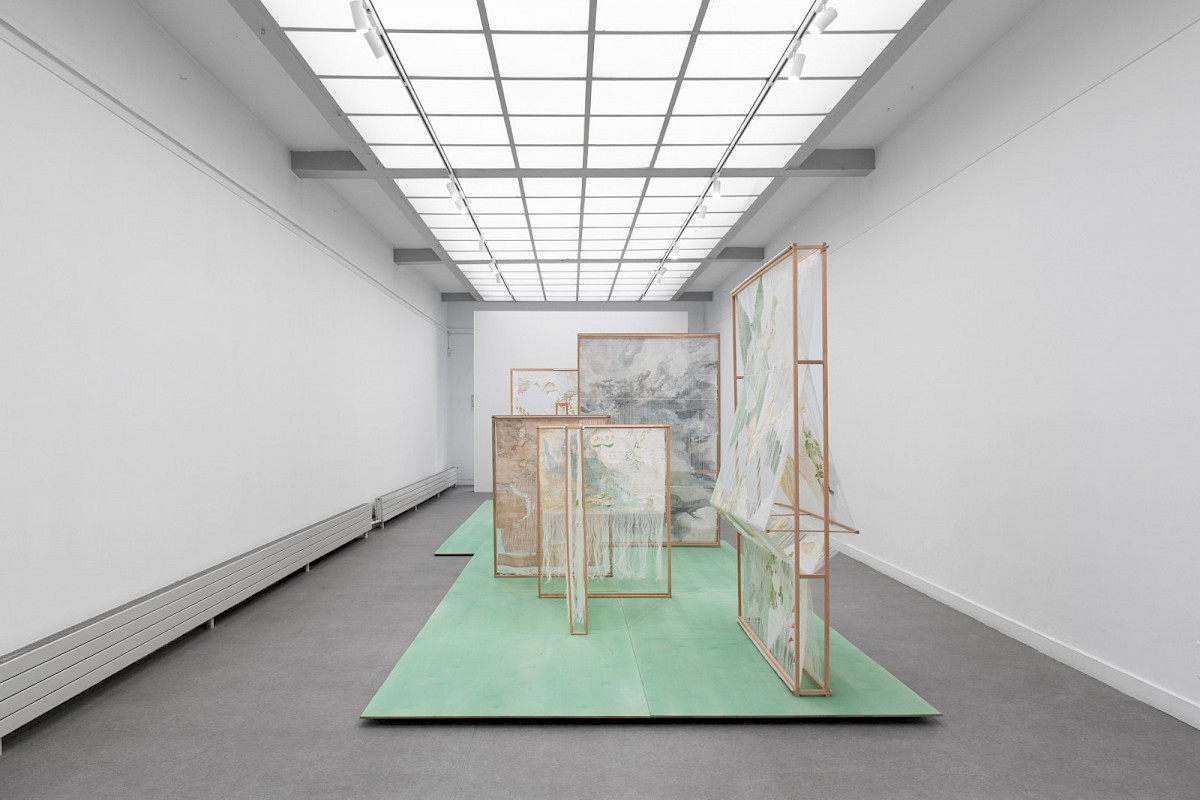
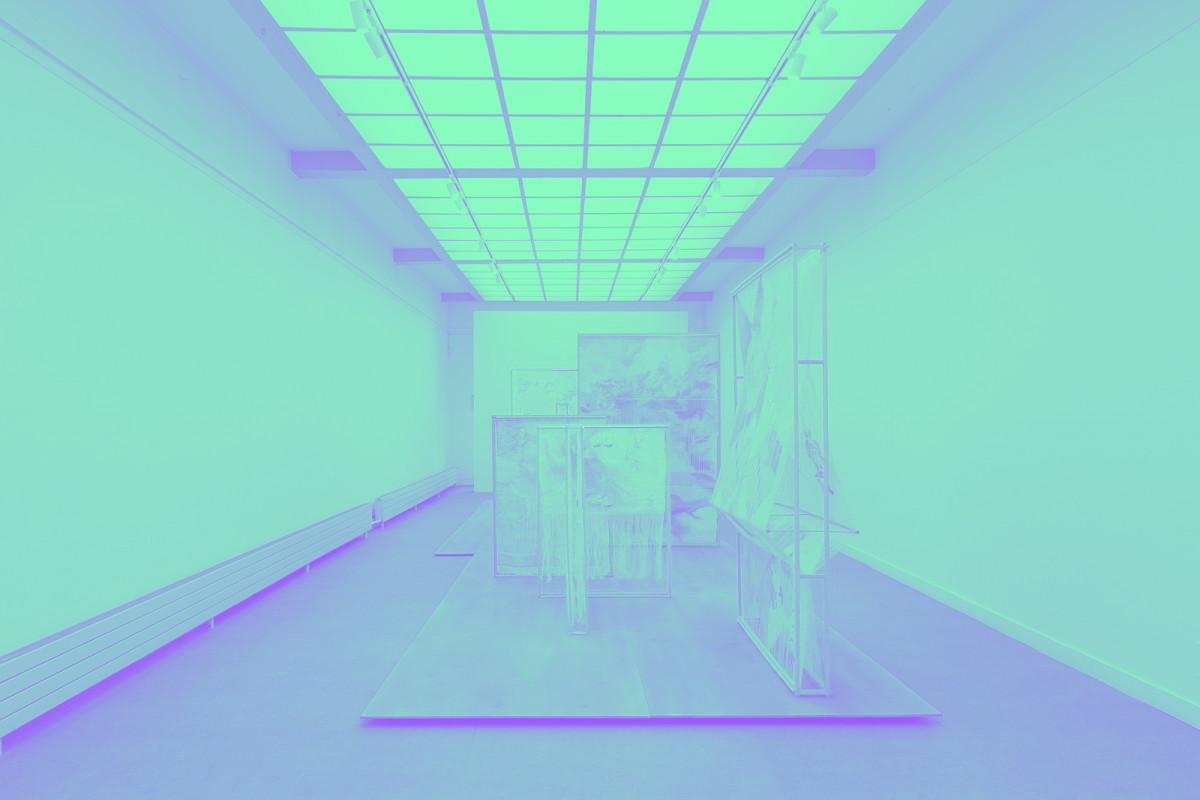
The Anachoresis
Since the beginning of her practice, Élise Peroi, through her work of weaving and the void, seeks to translate what traverses, the breath, the atmosphere. Inspired by the book Living off Landscape, or The Unthought-of in Reason by François Jullien, she seeks to translate an all-encompassing vision of the world, where all that surrounds us “is no longer a matter of ‘seeing’, but of living”.
Her work, which allows suspended spaces to appear, also evokes the notion of time, the workshop, and the tool. Translating what precedes the creation of a work refers to Paul Valéry’s text, The Philosophy of Dance, and encourages an awareness of the poetic aspect of gestures.
During her residency at the Academia Belgica in the spring of 2022, Élise Peroi chose to base her work on Augustin Berque’s book, History of the Ideal Habitat. From East to West, and interweave the notion of landscape and isolation based on three figures : the inhabitant of a villa, the anchorite, and the artist.
The piece Anachorèse – villa is thought in the form of a landscape fresco which would represent the view on the exterior of a Roman villa. This piece questions the paradox of man seeking a form of isolation from the world, a luxury of solitude. It speaks of the link between the villa and the concept of landscape.
The piece Anachorèse – mère sur désert is a diptych composed of a flowery landscape with the ochre tints of the desert and the image of a woman whose face is covered by a floral fabric, referring to the idea of interior landscape. In parallel, this piece questions the notion of “sensory deprivation “, evoking a form of asceticism in the early Christian era.
The ensemble also refers to the ambivalent attitude of the artist towards landscapes, between a figure that transmits and imposes his or her own vision.
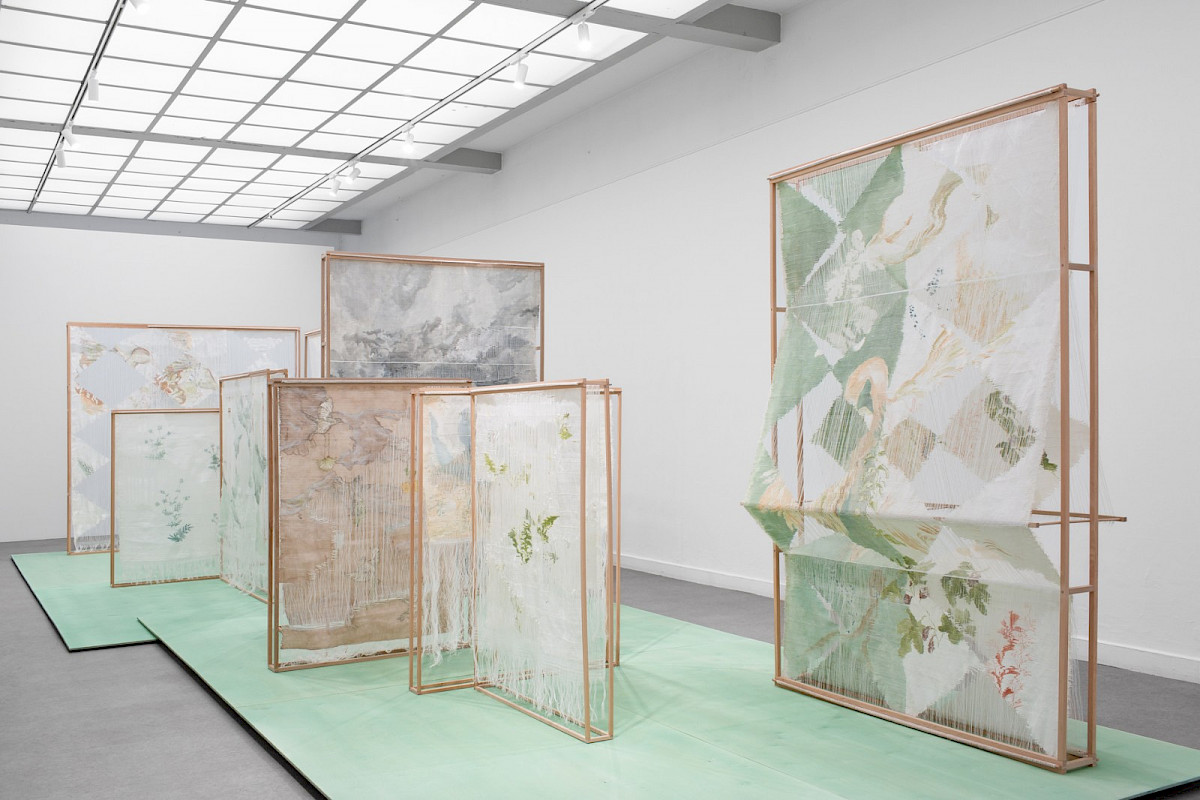
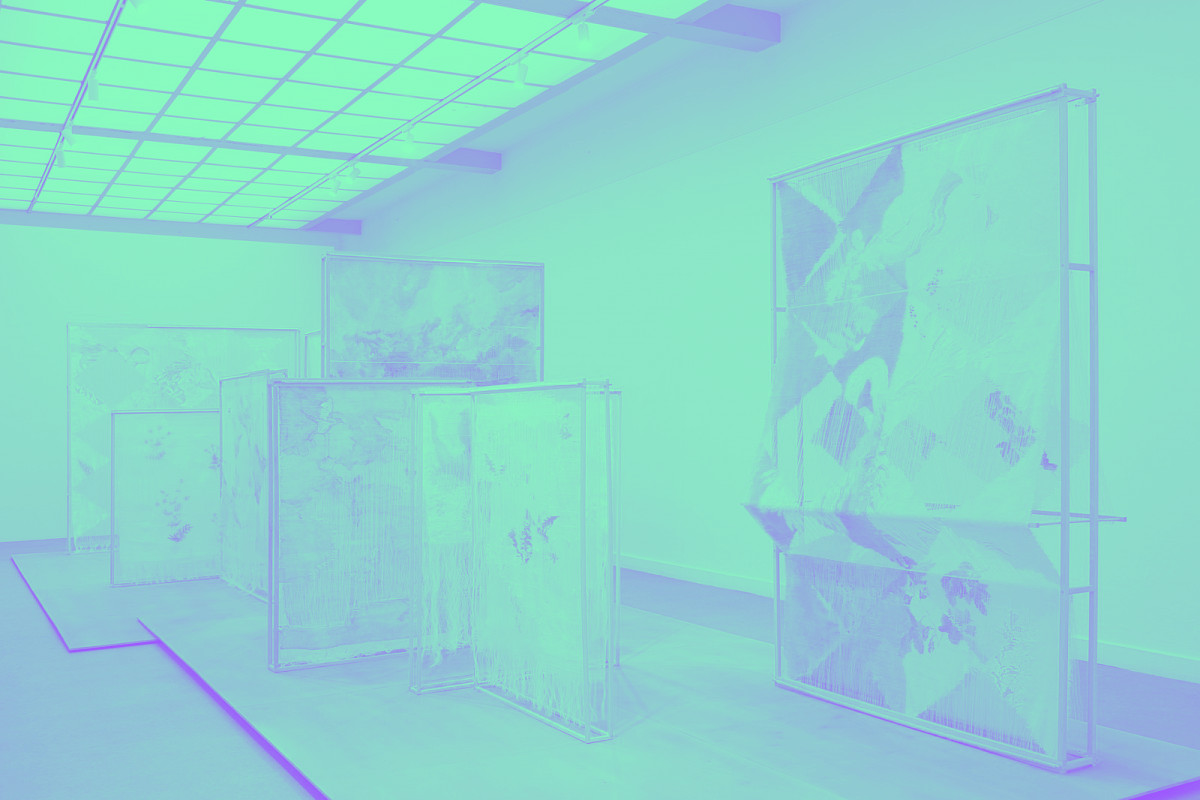
The Invisible Cities
If the first room of the exhibition dealt with wilderness, that is to say the quest for uninhabited spaces, we enter here in an opposite direction, where this time it is about the intrusion of nature in an inhabited space, that is to say, the city…
In her installation Les villes invisibles, Élise Peroi plays on the close link between architecture and textiles due to their common etymology, teks-. Inspired by Italo Calvino’s book of the same title, the space here becomes an imaginary city, transparent and fleeting like the mirage of those cities Marco Paulo described to the Great Khan, in the wake of his eternal travels. Throughout these urban landscapes, uncertain constructions rise up and suspended moons light up, as in the city of Lalage that the book describes, and where the inhabitants come to suspend the divine star so that it can rest.
Further on, placed on the floor like a still life, Les glanées assembles precious elements collected during the artist’s travels : plants, a shuttle in the shape of the moon confusing the cycle of this star with the gesture of weaving, a silver mulberry branch representing the cartography of a journey between France and Japan. This time, these elements refer to the wordless language through which Marco and Khan’s exchange takes place to describe with acuity the spaces they have traversed.
On the wall, the work S’attarder en surface represents the outline of these invisible cities. Eight woven maps, rolled and suspended, evoke the remembrance of those maps harnessed to the explorer’s body on distant expeditions. Eight steps towards the elsewhere, which, once deployed, could recreate the cartography of an imaginary journey.
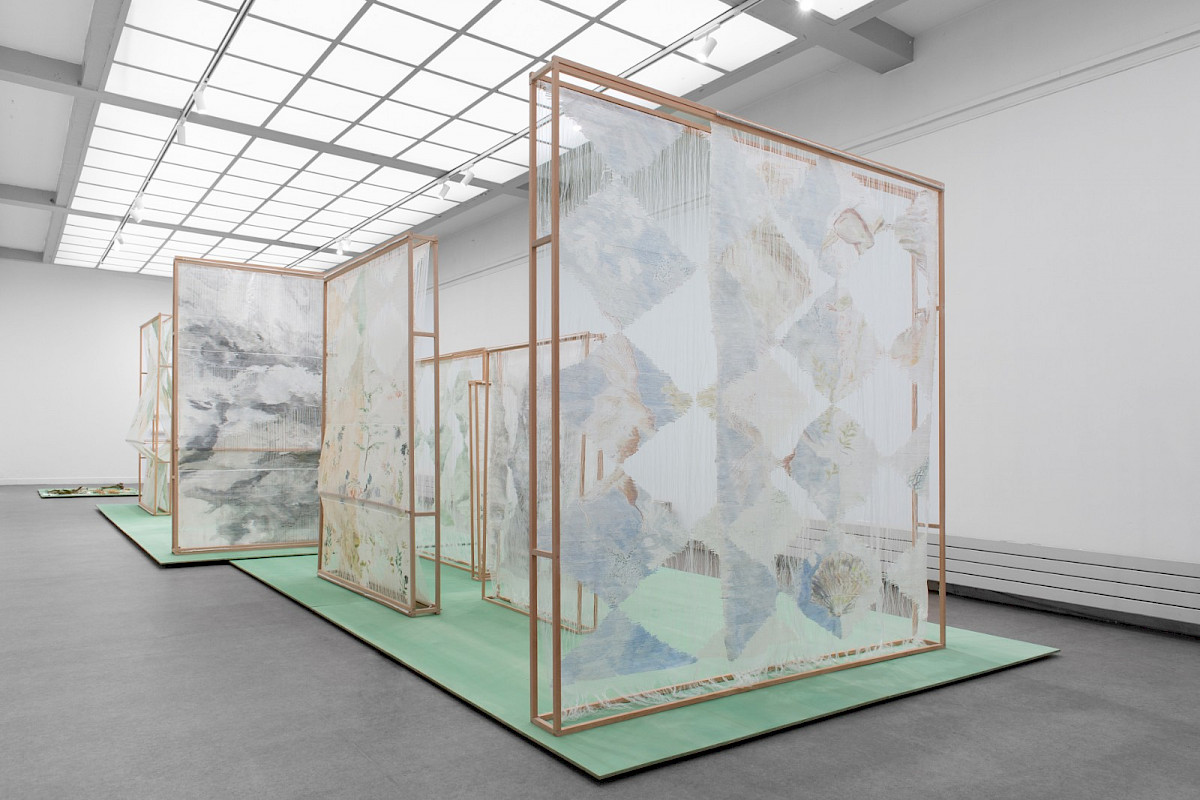
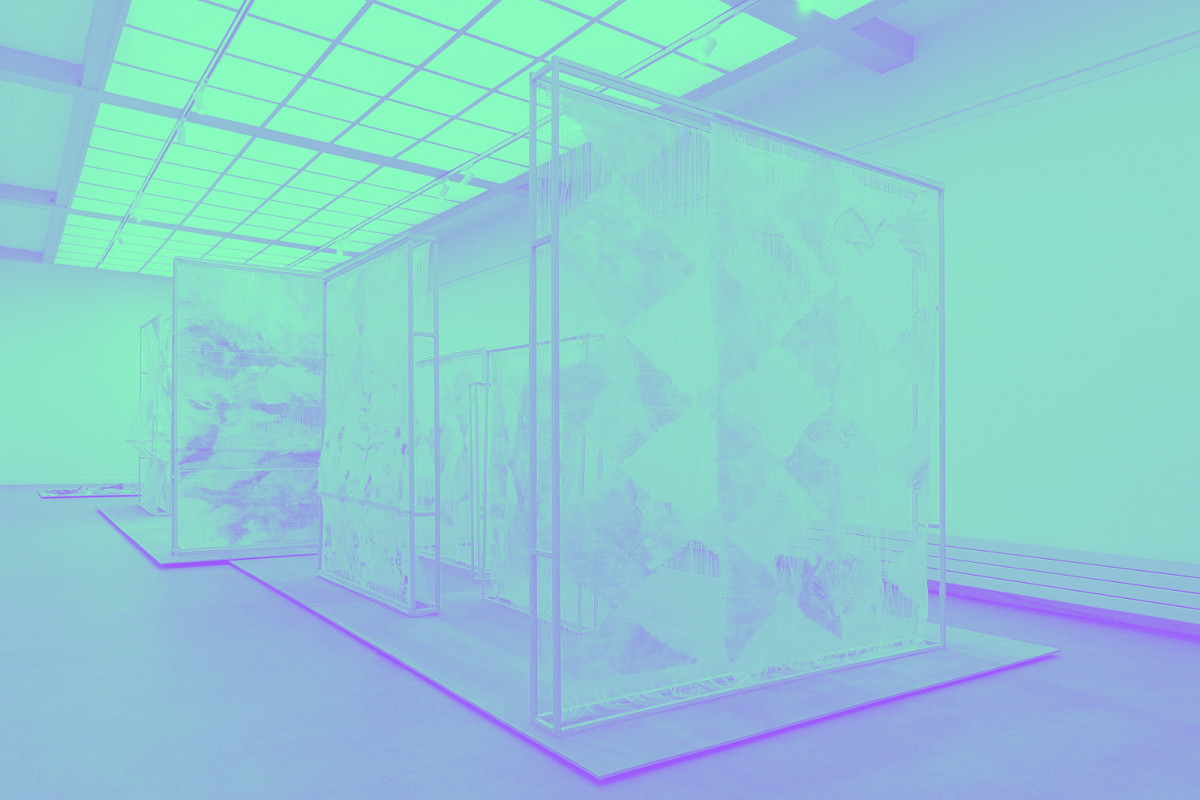
Biography of Élise Peroi
Born in Nantes (FR) in 1990, Élise Peroi lives and works in Brussels (BE). She graduated from the Royal Academy of Fine Arts in Brussels with a Master’s degree in Textile Design in 2015.
In 2016, with the support of the Halles de Schaerbeek, Brussels, she began to develop performances based on weaving.
The artist has participated in numerous group exhibitions since 2015 both in France and Belgium (Foresta, Le Bel Ordinaire, Pau (FR); Inspire, Iselp, Brussels ; Island/ish, Instituto Italiano di Cultura, Brussels, etc.). She is regularly invited for residencies as part of her work as a visual artist or performer : La Bellone, Brussels ; La Serre – arts vivants, Montreal (CA); Fédération Wallonie- Bruxelles, Ile de Comacina (IT); Fap, San Cipriano Picentino (IT), etc.
She collaborates with different choreographers, Mui Cheuk Yin, Louise Vanneste ; playwrights, Emmanuelle Nizou, Camille Louis, Émilie Martz-Kuhn and musicians, Roel Dieltiens, Marine Falque-Vert, Thomas Jean Henri. In 2020, she had her first solo exhibition Proche du Soleil at the Maria Lund Gallery in Paris. In 2021, her work was shown in two concurrent solo exhibitions in Brussels : Là où se trouve la forêt at the Botanique and Faire Sillons at the Centre Culturel de La Tour à Plomb.
In the spring of 2022, still in Brussels, she created the installation Carpe Diem at the ELEVEN STEENS Art Center, in parallel with her residency at the Academia Belgica in Rome.
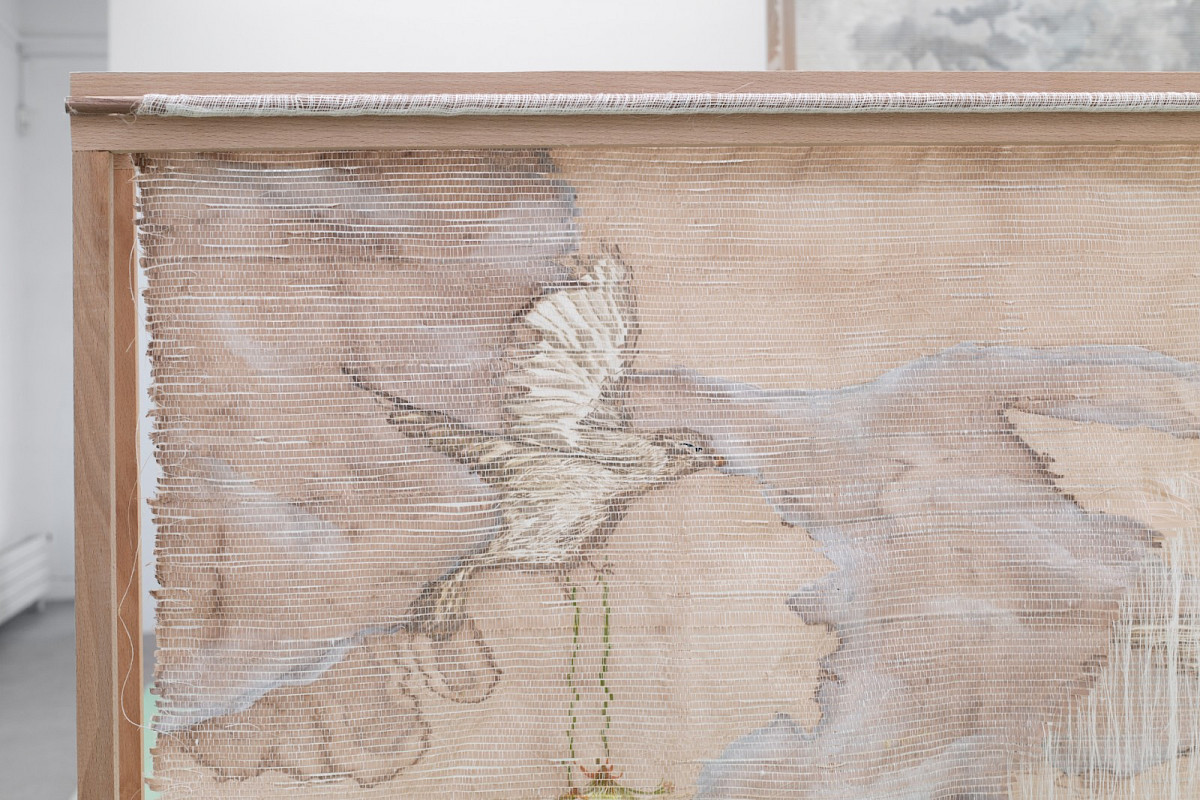
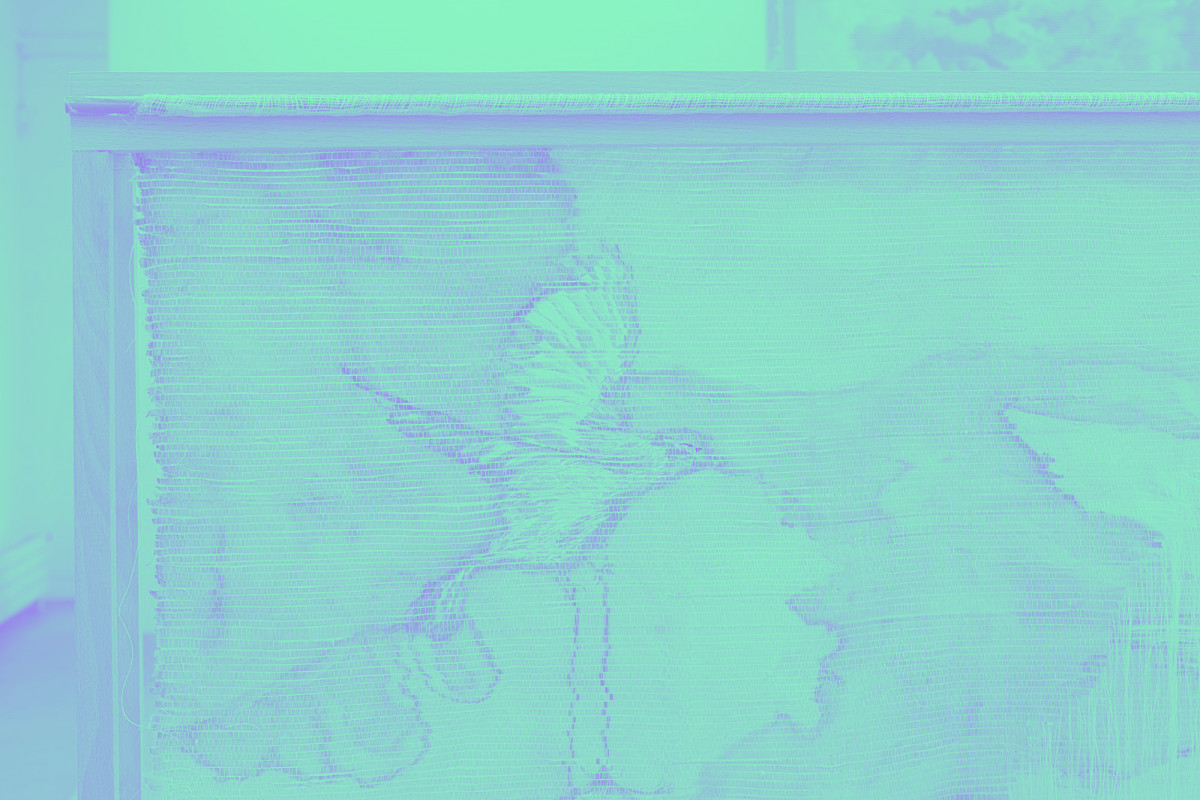
Biography of Jean-Marc Dimanche
Jean-Marc Dimanche is an artistic director with no preconceived ideas. After studying Pharmacology, he quickly turned to Art and Culture, creating the agency V.I.T.R.I.O.L. in the 1990s, a laboratory of ideas and creations specialized in the luxury sector, which he directed for 20 years. In 2008, in partnership with Florence Guillier-Bernard, he founded Maison Parisienne, a traveling gallery dedicated to fine crafts, which he left eight years later, after organizing more than fifty exhibitions in various European capitals. At the beginning of 2016, he was appointed advisor to Her Royal Highness the Grand Duchess of Luxembourg for the development and transmission of crafts in Luxembourg and in Europe, and created the biennial De Mains De Maîtres, of which he is now the general curator. Since spring 2019, date of its opening in Brussels, he also directs ELEVEN STEENS, a private space dedicated to Art and Material, open to all fields of creation, whether plastic arts, design, crafts, architecture, or fashion…
He has been a contributor to the Journal of Ceramics and Glass for several years and has participated in the writing of numerous catalogs and artists’ books.
